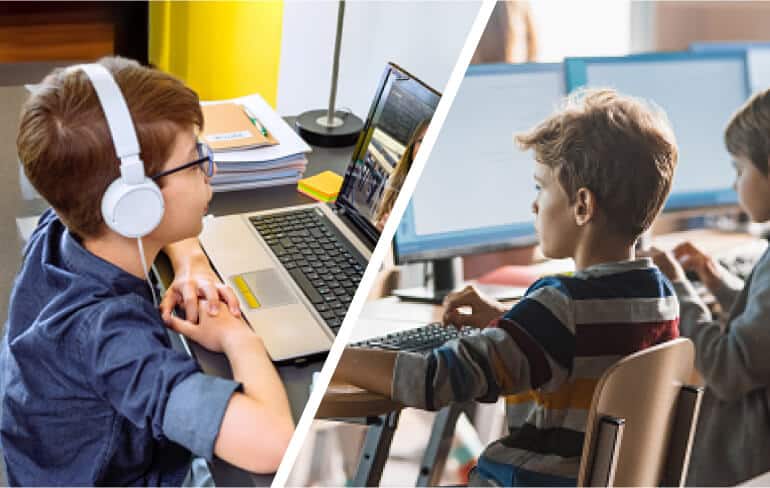The landscape of education has experienced significant changes in recent years, driven by technological advancements and the growing demand for flexible learning options. Traditional classrooms are no longer the only avenue for education, as online and hybrid models have emerged to cater to diverse student needs. Selecting the appropriate mode of learning is vital for your student’s academic success and well-being.
Choosing to enroll in a hybrid or online school is a significant step that requires careful consideration and planning, so, let’s dive into the benefits and challenges of each.
Understanding hybrid and online classes
Keep reading to understand what hybrid classes are, how they differ from fully online programs and why you might consider one over the other for your student’s educational needs.
What are hybrid classes?
Hybrid classes are a blend of traditional in-person instruction and online learning. This model allows students to experience the benefits of face-to-face interactions with teachers and peers while enjoying the flexibility of online resources.
In addition, hybrid classes provide ample opportunities for socialization. In-person sessions allow students to interact with their peers, participate in group activities and develop social skills that are essential for their overall growth. This blend of in-person and online learning helps maintain a sense of belonging, which can be a critical factor in a student’s emotional and social development.
A typical hybrid class schedule involves attending school on certain days of the week and studying online on the others. For example, a student might attend classes at school on Monday, Wednesday and Friday, while Tuesday and Thursday are dedicated to online learning. This structure provides a balanced mix of direct instruction and self-paced study, catering to different learning styles and needs.
For instance, a hybrid program like ASU Prep Digital+ is designed to meet the diverse needs of today’s high school students by combining online education with in-person support and community engagement. Students are able to customize their schedules based on their chosen pathway, attending in-person sessions up to four days a week, depending on their preferences and educational goals. This flexibility empowers students to take control of their learning journey, tailoring their education to fit their unique needs.
ASU Prep Digital’s hybrid learning program is particularly beneficial for students who need the social interaction and personalized guidance provided by face-to-face learning while still taking advantage of online resources.
Choosing between hybrid and online classes depends on your student’s unique needs and learning style. Hybrid classes offer a balanced approach, combining the personalized support and social interaction of traditional classrooms with the flexibility and resource-rich environment of online learning. By considering the benefits of hybrid classes, you can make an informed decision that supports your student’s educational success. Remember, whether hybrid or fully online, the goal is to provide an environment where your student can thrive and reach their full potential.
Benefits of hybrid classes
- Hybrid classes offer a blend of face-to-face and online learning, providing the best of both worlds.
- Direct interaction with teachers and peers during in-person sessions enhances understanding and strengthens relationships.
- Opportunities for socialization in hybrid classes support students’ emotional and social development.
- Flexibility in learning pace and access to online resources extend education beyond the classroom.
- Personalized support and immediate feedback are more accessible in hybrid settings.
- Hybrid learning fosters a sense of community and belonging among students.
- Fully online classes deliver unparalleled flexibility, allowing learning from anywhere at any time.
Challenges of hybrid classes
- Transportation may be a challenge, as students need reliable ways to attend physical school sessions.
- Time management is critical for balancing in-person classes and online coursework, requiring strong organizational skills.
- Balancing in-person and online learning components can create a disjointed educational experience, demanding adaptability in learning styles and focus.
- Transitions between in-person and online instruction may be challenging for students who prefer consistency.
- Families will need to provide extra support to navigate the scheduling complexities of hybrid education.
What are online classes?
Online classes, also known as virtual or digital classes, are an educational format where instruction and learning take place over the internet rather than in a traditional classroom setting. This mode of learning allows students to access course materials, participate in discussions and complete assignments entirely online. Unlike conventional face-to-face instruction, online classes offer a flexible and accessible approach to education, catering to diverse needs and schedules.
In a fully virtual learning environment, all aspects of the educational experience occur through digital platforms. Students and teachers interact via the internet, using various tools and technologies to facilitate instruction and learning. This setup eliminates the need for physical attendance, allowing students to participate from any location with an internet connection.
Virtual learning environments often include a mix of asynchronous and synchronous learning, including:
- Live lectures
- Virtual workshops
- Online lesson content
- Discussion forums
- Digital assessments
Online education also relies on a variety of tools and platforms to create an interactive and effective learning experience. Some of the key technologies used in online classes include:
- Learning Management Systems (LMS): Platforms like Blackboard, Canvas and Moodle serve as centralized hubs where students can access course materials, submit assignments and track their progress.
- Video Conferencing Tools: Applications such as Zoom, Microsoft Teams and Google Meet facilitate live lectures, group discussions and virtual office hours.
- Communication Tools: Email, messaging apps and discussion boards enable ongoing interaction between students and instructors.
- Educational Resources: Digital libraries, interactive simulations and multimedia content enhance the learning experience by providing diverse and engaging materials.
These tools work together to create a comprehensive online learning environment that supports both synchronous and asynchronous learning.
Online classes offer a fully virtual learning environment that provides flexibility and accessibility for students. By utilizing a range of digital tools and platforms, online education facilitates a dynamic and interactive learning experience.
Curious what online school is like? Check out our blog: What is online school like? All your questions answered!
Benefits of online classes
- Online classes offer flexibility, allowing students to learn from anywhere, anytime, fitting busy schedules and different time zones.
- Customized learning experiences cater to various learning styles with self-paced options.
- Online education offers access to an extensive range of resources and courses, including digital libraries and specialized programs.
- Offers the ability to balance education with other commitments, support for academic growth through personalized learning and opportunities to pursue specific interests or career aspirations.
- Provides a more personalized approach to education, helping students meet their academic and personal goals.
Learn more about how online schooling can benefit your student in our blog: Discover the benefits of online school for your student.
Challenges of online classes
- Online classes can reduce face-to-face social interaction, potentially leading to isolation.
- Online learning requires strong self-discipline and time-management skills due to the lack of structured physical classrooms.
- Online school requires access to a study space, setting a consistent schedule and using organizational tools.
Comparing hybrid and online classes
As education continues to evolve, many families are exploring various learning models to determine the best fit for their student’s needs. Among the most popular options are hybrid and online classes. Both offer distinct advantages and challenges, and understanding these can help you make an informed decision.
Hybrid learning vs. online learning comparison
| Component | Online Learning | Hybrid Learning |
|---|---|---|
| Structure | Entirely virtual | Combination of in-person and online sessions |
| Flexibility & Convenience | High (location and schedule) | Moderate (scheduled in-person days, flexible online days) |
| Teacher Interaction | Virtual interactions only | Face-to-face interactions combined with virtual interactions |
| Engagement | Dependent on online tools and course design | Enhanced by in-person interactions and varied learning experiences |
| Feedback | Delayed, primarily virtual | Immediate during in-person sessions |
| Learning Style Accommodation | Self-paced, requiring self-discipline and motivation | Caters to both collaborative and self-paced learners |
| Socialization Opportunities | Limited, virtual collaboration | Higher due to physical classroom presence |
| Challenges | Potential for isolation, requires proactive engagement | Requires time management and balancing between two environments |
| Tools Used | Video lectures, discussion forums, digital collaboration spaces | Lectures, group discussions, practical exercises, online platforms |
Making the right choice for your student
Choosing between hybrid and online classes for your student can be a pivotal decision in their educational journey. To ensure that you make the right choice, it’s crucial to assess your student’s learning style, preferences for structure versus flexibility and their level of self-motivation and independence. Here’s a few key steps to help you navigate this important decision.
Assessing your student’s learning style
Understanding your student’s learning style is crucial for choosing between hybrid and online classes. Hybrid classes, combining in-person and online learning, suit students who thrive on direct interaction and a structured schedule. They benefit from the routine and tangible connection of scheduled sessions while enjoying the flexibility of online resources.
Online classes are entirely virtual, ideal for self-directed students who prefer learning at their own pace, offering flexibility and a wide range of digital tools. To determine the best fit, consider whether your student excels in a structured or flexible environment, their need for routine and face-to-face interaction and their level of self-motivation and independence. By evaluating these factors, you can select the educational model that best supports your student’s academic success.
Evaluating family schedule and commitments
Deciding between hybrid and online learning models depends on your family’s routine, commitments and ability to manage logistics. Hybrid classes offer a mix of in-person and online learning but require careful coordination of transportation and schedules, fitting best with consistent routines and the capacity to handle school drop-offs and pickups.
Online classes, on the other hand, offer flexibility and adaptability to dynamic schedules, allowing learning at one’s own pace but require a structured home environment and self-discipline. Evaluate your family’s ability to support either model, considering factors like transportation, supervision and integration with family activities, to choose an educational approach that aligns with your lifestyle and supports your student’s learning needs.
Considering long-term goals
The educational choices you make today should support your student’s long-term goals. Hybrid and online classes each offer distinct advantages that can cater to different future aspirations.
For students with clear career goals that require specific skills or certifications, the hybrid model can offer targeted experiences and interactions with industry professionals. This hands-on approach can enhance their understanding of their chosen field and provide practical experience that can be beneficial for future academic and career pursuits.
If your student is considering higher education, online classes can offer advanced coursework and dual-enrollment opportunities that might align with their college goals. Many online programs provide pathways to earn college credits or certifications that can give students a head start in their academic careers. Additionally, online learning can help students develop essential skills such as time management, self-discipline and digital literacy—skills that are crucial for success in both higher education and the workforce.
Aligning your student’s educational choices with their long-term goals involves carefully evaluating how hybrid and online classes fit into their future aspirations. Whether your student is preparing for higher education or specific career paths, choose a model that provides the right balance of flexibility, support and practical experience. By aligning their current education with their future goals, you can help set them up for success in their academic and professional journeys.
Conclusion
Both online and hybrid courses offer unique advantages for maximizing learning time in a virtual classroom setup. Ultimately, the choice between online and hybrid classes should be based on the individual student’s learning style, needs and circumstances. By understanding the strengths of each model, educators and parents can make informed decisions that optimize educational outcomes and ensure a supportive and effective learning environment.
Researching online or hybrid school options?
Online schools and hybrid school environments are great options for families who need flexibility and accessibility with their student’s education. If you’re looking for more online learning options for your student, then reach out to ASU Prep Digital. Our accredited online school program serving students in grades K–12 is recognized as Arizona’s #1 Online School by Niche.com.
ASU Prep Digital’s unique teaching model supports students with the latest learning technologies and several layers of personalized instruction and coaching, through both online and hybrid options. In addition, our program is a college prep option where online high school and university courses converge, preparing students for college acceptance and encouraging them to start earning credit toward college majors and careers.
We support districts in Arizona, while serving students and schools around the world. To learn more about ASU Prep Digital, please visit our website.
Hybrid class vs online: Choosing the best for your student FAQs
What is hybrid learning?
Hybrid learning is an educational model that combines both in-person and online instruction. It allows students to participate in face-to-face classes at a physical location while also engaging in online coursework and activities. This blend of physical and virtual learning environments offers flexibility, as students can alternate between attending classes in person and working remotely. The hybrid model aims to provide the benefits of both traditional and digital education, offering a more personalized and adaptable learning experience.
What is the difference between hybrid classes and online classes?
The primary difference between hybrid and online classes lies in their structure and mode of delivery. Hybrid classes integrate both in-person and online components, requiring students to attend some classes on campus while completing other parts of their coursework online. This model provides a balance between physical classroom interaction and digital learning. On the other hand, online classes are conducted entirely over the internet, with all instruction, assignments and interactions happening in a virtual environment. Online classes offer complete flexibility as students can access materials and participate in discussions from anywhere, without the need to be physically present in a classroom.
Is hybrid better than online?
Whether hybrid is better than online learning depends on individual needs and preferences. Hybrid learning offers the advantage of face-to-face interactions with teachers and peers, which can enhance engagement, socialization and personalized support. It also provides a structured routine with scheduled in-person sessions. However, online learning offers greater flexibility, allowing students to complete coursework from any location and at their own pace. It can be particularly beneficial for those who prefer a fully virtual environment or have schedules that require more adaptability. Ultimately, the choice between hybrid and online learning should be based on your student’s learning style, academic needs and personal preferences.
How do hybrid classes work in comparison to fully online classes?
Hybrid classes work by blending in-person and online learning experiences. Students attend physical classes on a scheduled basis, which allows for direct interaction with instructors and peers. The rest of their coursework is completed online, offering the flexibility to study and complete assignments remotely. This combination provides the benefits of both in-person engagement and digital accessibility.
In contrast, fully online classes are conducted entirely through digital platforms. All instruction, assignments and interactions take place online, eliminating the need for physical attendance. Students in online classes can access materials and participate in discussions at any time, providing a high level of flexibility. However, this model may lack the immediate social and academic support found in traditional classroom settings.
Each model offers distinct advantages and can be chosen based on factors like your student’s learning style, schedule and the level of in-person interaction they need.








